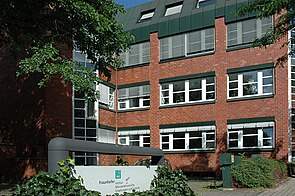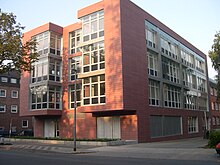Fraunhofer Institute for Microelectronic Circuits and Systems
| Fraunhofer Institute for Microelectronic Circuits and Systems |
|
|---|---|
 The Fraunhofer IMS |
|
| Category: | research Institute |
| Carrier: | Fraunhofer Society |
| Legal form of the carrier: | Registered association |
| Seat of the wearer: | Munich |
| Facility location: | Duisburg |
| Type of research: | Applied research |
| Subjects: | Engineering , natural sciences |
| Areas of expertise: | microelectronics |
| Basic funding: | Federal government (90%), states (10%) |
| Management: | Anton Grabmaier |
| Employee: | about 250 |
| Homepage: | www.ims.fraunhofer.de |
The Fraunhofer Institute for Microelectronic Circuits and Systems (IMS) is part of the Fraunhofer Society . The institute is based in Duisburg , and its activities are related to applied research and development in the field of microelectronics . Fraunhofer IMS is a member of the Fraunhofer Group for Microelectronics (VµE), to which ten Fraunhofer institutes belong.
history
The institute was founded in 1984. Today it is one of the leading institutes for applied research and development in the field of microelectronics. Until the end of 2001, Fraunhofer IMS had a branch in Munich, which was transferred to the Fraunhofer Institute for Reliability and Microintegration (IZM) on January 1, 2002 .
Research and Development
The institute is the only microelectronics institute in Germany to cover the entire breadth of the potential of microelectronics in the areas of components and technology, sensor technology and microsystem technology, circuit design and system and application technology, as well as CAD and testing.
The fields of work are divided into
-
CMOS image sensors and photodetectors
The applications cover various fields, e.g. B. Multimedia , automotive , industrial and building automation , robotics , environmental protection, medicine. - Wireless ICs / wireless communication
systems The main topics are: Telecommunications and microelectronic system concepts for product development, production and commissioning. -
Embedded Systems
Embedded hardware and software systems, e.g. B. Gateways , transponder base stations, but also for other products with embedded technical intelligence. - Manufacturing of wafers , CMOS processes and IC design
Based on the CMOS technology, application-specific processes are developed. CMOS process steps are used to manufacture silicon sensors and power components. Special processes for the production of MST components (sensors) are integrated into the CMOS process. - High temperature chips and EEPROM applications
A high temperature CMOS process for up to 250 ° C on SOI substrate is also available. The EEPROM applications range from the storage of calibration and identification data to larger storage arrays for measurement data loggers . - Smart living and in-home
-
Sensor technology and sensor signal
processing Development of absolute and differential pressure sensors using silicon micromechanics, including pressure sensors for high pressure or high temperature applications. -
Transponders and Smart Label
SmartCards , SmartLabels and keys for immobilizers are well-known examples of transponder technology.
The institute has a 1,600 m² class 10 clean room . Over 80,000 wafers can be produced here every year. In the clean room, 120 people work in three shifts, seven days a week. For the CMOS pilot production, the IMS works closely with the Elmos company .
Infrastructure
Approx. 250 people are employed in the institute.
The operating budget in the 2009 financial year was 18 million euros (2006: 15 million euros). 15% of these came from the basic funding, 90% of which is financed from federal funds and 10% from state funds. The third-party funding quota was around 85% in that year, around 60% of which came from contract research by the private sector and around 40% from earmarked funds from the federal and state governments (mainly project funding, see grant ).
The institute has been headed by Anton Grabmaier since 2006. Günter Zimmer headed the institute from its foundation until 2005.
Web links
Footnotes
Coordinates: 51 ° 25 ′ 44.1 ″ N , 6 ° 47 ′ 48.4 ″ E


